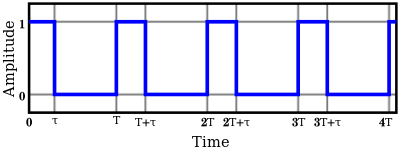Pulse wave

A pulse wave or pulse train is a kind of non-sinusoidal waveform that is similar to a square wave, but does not have the symmetrical shape associated with a perfect square wave. It is a term common to synthesizer programming, and is a typical waveform available on many synthesizers. The exact shape of the wave is determined by the duty cycle of the oscillator. In many synthesizers, the duty cycle can be modulated (sometimes called pulse-width modulation) for a more dynamic timbre.[1] The pulse wave is also known as the rectangular wave, the periodic version of the rectangular function.
The Fourier series expansion for a rectangular pulse wave with period T and pulse time τ is
Note that, for symmetry, the starting time (t = 0) in this expansion is halfway through the first pulse. The phase can be offset to match the accompanying graph by replacing t with t - τ/2.
A pulse wave can be created by subtracting a sawtooth wave from a phase-shifted version of itself. If the sawtooth waves are bandlimited, the resulting pulse wave is bandlimited, too. Another way to create one is with a single ramp wave (sawtooth or triangle) and a comparator, with the ramp wave on one input, and a variable DC threshold on the other. The result will be a precisely controlled pulse width, but it will not be bandlimited.
Acoustically, the rectangular wave has been described as having a more "narrow and nasal" sound than a perfect square wave, and its characteristic sound features prominently in many Steve Winwood songs.[2]